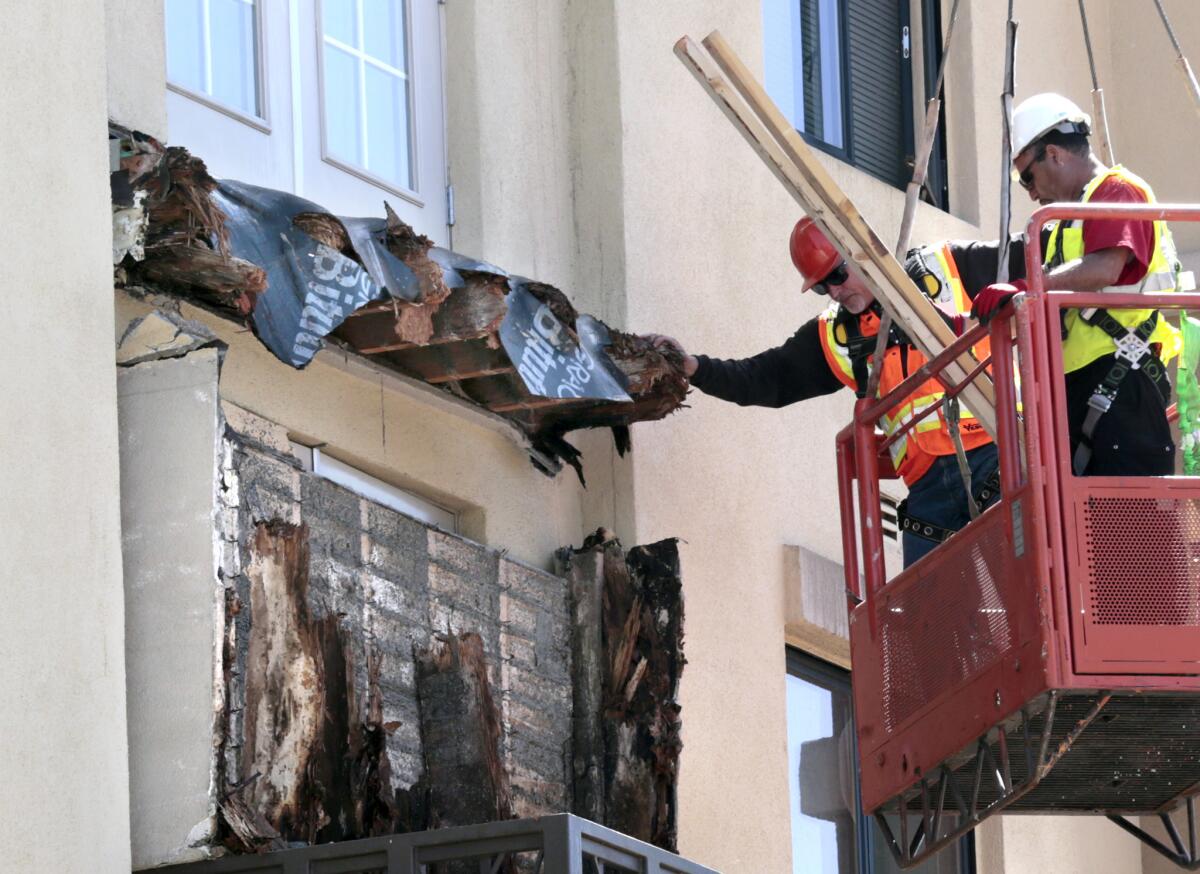Berkeley calls for new inspection, construction rules after balcony collapse

A crew works on the Berkeley apartment building where a balcony collapsed in mid-June, killing six people and injuring seven.
Reporting from Berkeley — City officials proposed new inspection and construction rules Tuesday aimed at preventing another balcony collapse like the one that left six dead and seven injured last week.
The failure of the cantilevered, fifth-floor apartment balcony during a 21st birthday celebration also drew scrutiny by officials beyond Berkeley. A spokeswoman said the Alameda County district attorney’s office “was reaching out to the city of Berkeley and our office will begin looking at this matter.”
And state officials said they would look into whether changes need to be made in California’s building code.
“We need to look at all contributing factors, including possible dry rot and the building code to determine the best possible solution,” said Evan Gerberding, a spokeswoman for the state Department of Housing and Community Development.
In a report released a week after the incident, officials with Berkeley’s Building and Safety Division confirmed suspicions that dry rot had deteriorated the wood beams supporting the balcony. They also said they found no construction code violations. Their review involved many of the same documents the division relied on to allow residents to move into the 176-unit complex in 2007.
Instead, they found problems with the code itself and proposed changes. Their findings raised questions about whether existing building codes are adequate to ensure public safety on similar balconies across the state.
In Los Angeles, a spokesman for the Department of Building and Safety said it is difficult for local governments to make that kind of guarantee. The city, like many others across the state, has no way to assess the ongoing integrity of balconies once construction is complete and people move in.
“There is no way to ensure that balconies are totally ‘safe,’ “ spokesman David Lara wrote in an email. “There are many circumstances that could trigger accidents such as the one in Berkeley.”
Municipal building codes often lag behind industry standards and following them doesn’t absolve a builder of liability, said Tom Miller, a lawyer who represents homeowners in Southern California and the Bay Area.
“Built ‘to code’ doesn’t mean there weren’t mistakes,” Miller said. “Whenever there is dry rot, that means somebody didn’t do something right.”
For example, the city’s rules, which are based on the state code, did not require inspectors to check the balcony’s waterproofing during construction.
The rules proposed Tuesday would not impose such a requirement. Instead, they would force owners to inspect all balconies, stairways and elevated decks in apartments and other multi-unit housing complexes at least once every five years.
Officials also want vents installed underneath balconies, decks and stairs.
Finally, authorities want to ban the use of untreated engineered wood — wood that is pressed together in factories and that some experts say is more at risk for dry rot.
Instead, city officials want builders to use costlier wood that is naturally resistant to dry rot, such as redwood, mahogany and Brazilian walnut; wood that is treated with preservatives that fend off rot and insects; or corrosion-resistant steel.
Some experts criticized the review for failing to answer the central question of why the waterproofing failed.
“We won’t determine how moisture got in,” Berkeley planning director Eric Angstadt told reporters at a news conference. “Our analysis is complete, and we are not going to be conducting any further investigation.”
The new rules “would prevent the dry rot from advancing so quickly,” he said, and “are designed to deal with water intrusion no matter how it happens.”
Bill Leys, a San Luis Obispo waterproofing consultant, said the city should get to the bottom of the problem.
“There’s a reason that water got in, and the reason needs to be discovered, so it can be prevented in the future,” Leys said.
Leys also said it was unnecessary to ban conventional wood or certain types of engineered wood.
“For 100 years or more, we’ve been building with traditional, regular wood and as long as it’s protected from water intrusion, it does just fine,” Leys said. “But if it gets water trapped in it, it’s doomed to fail.”
Myron Moskovitz, a lawyer who represented Berkeley in a rent control case before the state Supreme Court, said the city department that signed off on the original construction had no business investigating the collapse.
“They have a conflict of interest,” Moskovitz said. “Someone else should do it. I think the county grand jury ought to be looking at this.”
The district attorney’s office, which has the power to organize a grand jury investigation, did not detail the nature of its inquiry.
It is not the first time building hazards have drawn such scrutiny. In 1996, the collapse of a fourth-floor balcony during a cocktail party in San Francisco left one woman dead and 14 other people injured. Prosecutors said the landlord’s neglect of the building was so egregious that they charged him with manslaughter. The jury was unable to reach a verdict on that charge but convicted him of misdemeanors.
City officials said they could introduce the new rules at a Berkeley City Council meeting as early as July 15. If they pass, building owners will have six months to inspect balconies.
Girion and Lin reported from Los Angeles, Romney from Berkeley. Times staff writers Paige St. John in Sacramento and Javier Panzar in Los Angeles contributed to this report.
More to Read
Sign up for Essential California
The most important California stories and recommendations in your inbox every morning.
You may occasionally receive promotional content from the Los Angeles Times.













